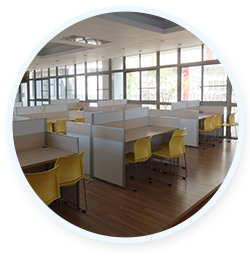
One of the first two departments established in the National Chiao-Tung University (NCTU):
The Electrophysics department was established in 1964, one of the first two departments founded under then the Institute of Electronics belonging to the newly established Engineering College. The department later became one of the founding cornerstones of the Applied Sciences College. In 1980, the department added the Institute of Electro-Optical Engineering, which in 1988 was incorporated into the College of Electrical Engineering and Computer Science. In 1993 the faculties of the department participated and assisted in the founding of the Institute of Physics. Our department started to offer MS degree programs in 1988 and PhD programs in 1990. Currently, students are given the option of enrolling in either the Electrophysics group or Photonics and Nano-Sciences group.

Unique department in Taiwan:
The Electrophyics department came into being in order to meet the needs for fast growing research in the fields of semiconductor and photonic physics, related devices, and the booming worldwide electronic industries in the early 60s. The name as it stands is adapted from the words “electronics” and “physics”. The department gained the leading position in both semiconductor and laser research and teaching programs soon after its establishment. Thus, it helped consolidate NCTU’s unchallengeable reputation in these fields within Taiwan.
Two major study programs:
To meet the challenges of the progressing nano-science and technology of recent years, the department is putting emphasis on the study of this field and offers the program of Photonic and Nanometer Science in the year 2004, alongside the long-existing Electrophysics Program. The Electrophysics program stresses the study of semiconductor physics, condensed matter physics, electronic science and theoretical physics; contrast to the newly establish program that devotes in Photonic and Nanometer Science mainly.
Cutting-Edge Research Activities:

Multi-discipline research groups in the fields of condensed matter, solid state lasers, photonic semiconductors, quantum calculation and spin physics have been formed to meet the challenge of the rapid progression of physics and to keep our leading academic position:
- The condensed matter group is devoted to the research of thin film superconducting and magnetic materials.
- Solid-state laser group studies and and fast emitting optical mode lasers.
- Optoelectronic Semiconductors group conducts research on and develops device quality light-emitting nitrides and a large variety of other compound semiconductors. Nano-scale experimental instruments and nano-technique of measurements are well facilitated and widely applied.
- Quantum Calculation research group lays stress on the theoretical study of entanglement states and nano-processing quantum devices for quantum transportation and ultra-fast spectroscopic investigation.
- Spin physics research group studies spin current generating mechanisms, spin-Hall effect and prepares nano-quantum and semi-magnetic material samples for such studies.
- Ultra-fast laser research group studies sub-femto second ultra-short laser pulse generation and its spectroscopic detection, as well as its application to the observation of many ultra fast processes in various materials.
In additional to the preceding research groups, faculties are also involved in the fields of nano-biotechnology, ultra-fast laser spectroscopy, nonlinear optics, optical information and optical communication, single-photon detection, single-photon detection, liquid crystal physics, and low-dimensional system under extreme conditions of ultra-low temperature, ultra-high magnetic field and ultra-high hydraulic pressure, and quantum computation on the physical properties of nano-structures.
Top-notch equipment and facilities
Each research group’s laboratory in the department is armed with the most updated equipment needed for research, teaching, and training purposes. Alongside the pursuit of educational and research superiority, our well equipped laboratory instruments also ensure the narrowest gap between the industrial environment surrounding us and our research activities. Below are the high-lights of our equipment systems: Molecular Beam Epitaxy, Organometallic Vapor Phase Epitaxy, Laser Deposition, Micro Raman and Photoluminescence Spectroscopes, High Magnetic Field Photoluminescence Spectroscopes, High Magnetic Field Electron Transportation, Ultra Fast and Spatial Resolution Spectroscope, Femtosecond Time Resolution Spectroscope, Nanometer Near Field Scanning Microscope, Atomic Force, Low Temperature Scanning Probe Microscope, and Laser tweezers. These facilities render our colorful training programs and vigorous research endeavors possible and prosperous.

Faculty Members & Research Fields
Most of our faculty members are Ph.D. holders from renowned worldwide universities. The majority is from the U.S.A. universities. Among our faculty members are winners of the Outstanding Research Award from the National Science Council, Outstanding Contribution Awards from the Physical Society of the Republic of China, and Sun Yat-Sen Academic Award from the Ministry of Education, and the recipients of the Excellent Teaching Award of NCTU.
The fields of interest of the faculties are listed below in the table, which are categorized into Semiconductor Physics and Devices, Condensed Matter and Theoretical Physics, Optoelectronic Science and Nano-techniques.



